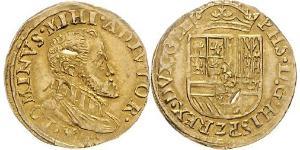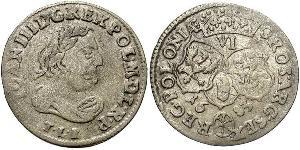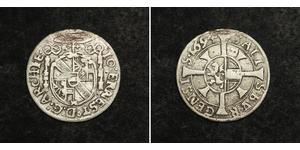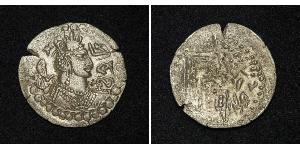(sold for $401.0)
1348, Feodal France, Cambrai Bishopric, Gui de Ventadour. Gold Florin Coin. R!
Mint Place: Cambrai
Denomination: Gold Florin
Mint Period: 1342-1348 AD
Reference: Friedberg 102, Delmonte 271. R!
Condition: Crudely struck, with minor planchet cracks and some weakness of strike (as made), otherwie VF+
Weight: 3.38gm
Diameter: 20mm
Material: Gold!
Obverse: Saint John standing facing.
Legend: ·S· IOHA-NNES· B· (privy mark: bird)
Reverse: Large lis symbol (resembling the florentine arms, which made the gold florin a popular and solid currency).
Legend: + FLOR'- EPI'· CA'
Buy with confidence!
The Roman Catholic Archdiocese of Cambrai (Latin: Archdiocesis Cameracensis) is an archdiocese of the Latin Rite of the Roman Catholic Church in France, comprising the arrondissements of Avesnes-sur-Helpe, Cambrai, Douai, and Valenciennes within the département of Nord, in the region of Nord-Pas-de-Calais. The current archbishop is François Charles Garnier, appointed in December 2000. Since 2002 the archdiocese has been a suffragan of the Archdiocese of Lille, reversing the prior arrangement.
Originally erected in the late 6th century as the Diocese of Cambrai, when the episcopal see after the death of the Frankish bishop Saint Vedast (Vaast) was relocated here from Arras. Though subordinate to the Archdiocese of Reims, Cambrai's jurisdiction was immense and included even Brussels and Antwerp.
In the early Middle Ages the Diocese of Cambrai was included in that part of Lotharingia which at first had been allocated to the West Frankish king Charles the Bald by the Treaty of Meerssen of 870 but, after various vicissitudes, came under the rule of the German king Henry the Fowler in 925. After the revolt by Duke Gilbert of Lorraine collapsed at the Battle of Andernach of 939, Louis IV of France renounced the Lotharingian lands, and in 941 Henry's son and successor King Otto I of Germany ratified all the privileges that had been accorded to the Bishops of Cambrai by the Frankish rulers.
In 1007, the Bishops gained an immediate secular territory when Emperor Henry II invested them with authority over the former County of Cambrésis; the Bishop of Cambrai thus became the overlord of the twelve "peers of Cambresis". The Prince-Bishopric of Cambrai became an Imperial State, located between the County of Hainaut and the border with Flanders and Vermandois in the Kingdom of France, while the citizens of Cambrai struggled to gain the autonomous status of an Imperial city. In the 14th and 15th centuries, the bishopric was temporarily a protectorate of the Burgundian dukes, which in 1482, as part of the inheritance of Mary the Rich, passed to her husband Maximilian I of Habsburg.
Cambrai from 1512 was part of the Imperial Lower Rhenish–Westphalian Circle and – like the Prince-Bishopric of Liège – was not incorporated into the Seventeen Provinces of the Burgundian Circle. Nevertheless the creation in 1559 of the new metropolitan See of Mechlin and of eleven other dioceses in the Southern Netherlands was at the request of King Philip II of Spain, in order to facilitate the struggle against the Reformation. The change greatly restricted the limits of the Diocese of Cambrai, which, when thus dismembered, was made by way of compensation an archiepiscopal see with the dioceses of Saint Omer, Tournai and Namur as suffragans. The councils of Leptines, at which Saint Boniface played an important role, were held in what was then the part of the former Diocese of Cambrai in the Southern Netherlands.
Under King Louis XIV the Bishopric of Cambrai finally became French after the Siege of Cambrai of 1677, confirmed in the Treaties of Nijmegen of 1678 and 1679. From 1790 Cambrai was part of the new Nord department. By the Napoleonic Concordat of 1801, Cambrai was again reduced to a simple bishopric, suffragan to Paris, and included remnants of the former dioceses of Tournai, Ypres, and Saint Omer. In 1817 both the pope and the king were eager for the erection of a see at Lille, but Bishop Louis de Belmas (1757–1841), a former constitutional bishop, vigorously opposed it. Immediately upon his death, in 1841, Cambrai once more became an archbishopric, with the diocese of Arras as suffragan.

|
Posted by:
anonymous 2016-01-10 |
1 Tetradrachm Seleucid Empire (312BC-63 BC) Silver
group has 20 coins / 19 prices
⇑
1 Thaler Austrian Empire (1804-1867) Silver Francis II, Holy ...
group has 92 coins / 90 prices
⇑















-300-150-yP0Kbzbi2McAAAFLXn2jlsyK.jpg)

-300-150-VTsKX9IS6aAAAAFZr5S1mgkc.jpg)






